

EXPLORE BY TOPIC:
  Our top 10 resources
Our top 10 resources
  Childhood / Early Life
Childhood / Early Life
  Chronic Stress
Chronic Stress
  Education
Education
  Food Security
Food Security
  Genetics
Genetics
  Jobs & Work
Jobs & Work
  Housing / Neighborhoods
Housing / Neighborhoods
  Income & Wealth
Income & Wealth
  Race / Racism
Race / Racism
  Social Inclusion
Social Inclusion
  Policy & Change
Policy & Change





Buy the DVD
e-Newsletter
FAQs
Contact Us
Site Map
Home

|
 |


|
Background: In the United States, street address and zip code are surprisingly good predictors of health. Why? Because the social, economic, and physical environments in which we live powerfully shape our life chances and wellbeing - for better and worse.
Where we live is not simply a matter of personal preference. It has a profound impact on financial security, school quality, job opportunities, safety, as well as access to goods and services. Unfortunately, racial segregation and past housing and loan discrimination have helped create inequities in neighborhood quality and the distribution of wealth and health.
Among other things, communities with lower income and educational levels tend to have higher rates of asthma, obesity, diabetes, heart disease, and child poverty. They are also more likely to have substandard housing, underfunded schools, poor access to grocery stores and supermarkets, and to be located near toxic industries and other sources of pollution.
On the other hand, well-off neighborhoods include many resources that help protect and sustain individual and group health: safe streets, well-maintained public spaces, good schools, libraries and other amenities, community programs, clean air, and good access to jobs and healthy food options.
Several overlapping factors play an important role in shaping health directly and indirectly:
Physical environment. Built space, infrastructure, and environmental quality all have a direct impact on our wellbeing. Old, substandard housing is more likely to have peeling paint, exposing families to dangerous lead levels, as well as pests and mold, which increase the risk of infectious disease and respiratory ailments like asthma. Geographic access to jobs, services and safe places to exercise and play shapes behaviors, choices and economic opportunities. Proximity to polluting industries, waste, freeways, and other hazards affects the air we breathe, the water we drink and the land we live on. Noise pollution also affects our anxiety and stress levels, which increase our risk for chronic illness.
Economic environment. Wealth, employment and economic mobility are important to foster good health, now and in the future. High housing costs threaten food and financial security, while concentrated poverty and a lack of good jobs lead to crime and disinvestment. On the flip side, home ownership brings financial security; attracts public and private investment in businesses, schools and infrastructure; and also promotes neighborhood cohesion - all of which are beneficial to health. Job training and access to good jobs with benefits, decent pay and career ladders help families avoid falling into financial disaster and reduces their risk for premature death and chronic disease.
Social environment. Communities that have strong social networks and foster social inclusion are healthier. Isolation and lack of support not only contribute to illness, they disempower individuals and communities. Neighborhoods where residents gather and help one another can foster belonging, affirmation and increased civic participation. They also have a bigger voice: organized groups can better advocate for their needs, reduce crime and increase safety, and bring health-promoting resources and services into their environment.
Resources and services. Our access to grocery stores and supermarkets, reliable transportation, clean parks, safe streets, community programs and institutional services reflect larger structural patterns of opportunity and advantage in society. Nevertheless, they impact our ability to make healthy choices, to gain skills and knowledge, to get adequate health care, fire protection and police protection, to avoid injury and live relatively unencumbered by fear, and fundamentally, to ensure that our basic needs are met and that we have a future to look forward to.
Together, these elements determine our health in subtle and obvious ways. Ensuring that every community is the healthiest it can be requires community organizing, political will, and public investment. Strategies to revitalize neglected areas, clean up environmental hazards, improve schools and foster economic development and wealth are critical they but must include and respond to the needs of residents, who more often than not are painfully aware of what is wanting in their communities.

|
|
|
| |
|
Housing / Neighborhoods: 0 items found |
 A Place for Healthier Living: Improving Access to Physical Activity and Healthy Foods A Place for Healthier Living: Improving Access to Physical Activity and Healthy Foods 
REPORT from the Joint Center for Political and Economic Studies and PolicyLink, June 2004 There are significant, persistent disparities in the prevalence and consequences of chronic illnesses: disparities of race, ethnicity, and income that are linked not just to nutrition and physical activity directly, but also to the social, economic and community-level conditions in which people live. These conditions largely shape people's capacity to maintain a good diet and a life that includes healthful physical activity. While individual behavior and access to quality health services are key, these disparities will not be eliminated without addressing community conditions. This brief explains the importance of community and neighborhood to the obesity epidemic, and proposes solutions.
|
 |
 A Tale of Two Smokers A Tale of Two Smokers 
ONLINE INTERACTIVITY based on UNNATURAL CAUSES Two people, one rich and one poor, are told by their doctor to stop smoking and lose 30 pounds in six months. See the challenges they face as they try to follow their doctor’s orders.
|
 |
 Addressing Poverty in TB Control: Options for National TB Control Programmes Addressing Poverty in TB Control: Options for National TB Control Programmes 
REPORT from the World Health Organization, 2005 WHO's commitment to the promotion of equity and pro-poor policies in its disease prevention and control activities is based on the recognition of poverty as a major barrier to health and health care. In the case of tuberculosis (TB), the links between poverty and disease burden have been documented for many years. This document addresses the integration of national TB control programmes on the practical issues involved and options for action. |
 |
Anchor Richmond - Community Opportunities & Anchor Strategies for the Berkeley Global Campus at Richmond Bay 
https://haasinstitute.creatavist.com/anchorrichmond Place Matters Follow-up:
What’s happening in Richmond, California?
The “Place Matters” episode of Unnatural Causes focuses on the city of Richmond, California. Much has happened in Richmond since the film’s release, including a 45% reduction in homicides and an attempt to pass the nation’s first soda tax (it lost thanks to millions of dollars spent by the soda and beverage industry).
Now UC Berkeley is planning a new campus in Richmond. This report by the Haas Institute for a Fair and Inclusive society looks back at Richmond, and forward to a unique opportunity to build new models of partnership ensuring the new Berkeley campus expands opportunity and community health for all. There are lessons here for how campuses, hospitals and other anchor institutions in marginalized communities across the nation can serve inclusion and equity, not displacement. |
 |
 Asian Pacific Environmental Network Asian Pacific Environmental Network 
WEB SITE "APEN seeks to empower low-income Asian Pacific Islander (API) communities to achieve environmental and social justice. APEN believes that the environment includes everything around us: where we live, work and play. And we strive to build grassroots organizations that will improve the health, well-being and political strength of our communities." |
 |
 Atomic Testing in the Marshall Islands Atomic Testing in the Marshall Islands 
WEB-EXCLUSIVE VIDEO, Unnatural Causes
Between 1946 and 1958, the U.S. detonated 67 nuclear devices in and around the Marshall Islands. The impact of these tests on the Marshallese people was profound - in terms of both actual radioactive exposure and the displacement of people from their home islands due to contamination and to accommodate the U.S. military. |
 |
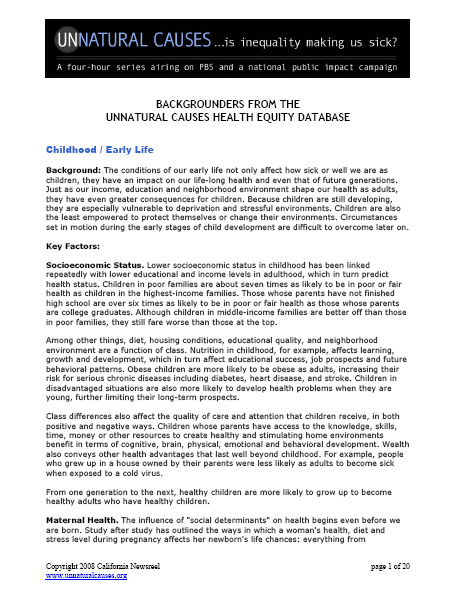 Backgrounders on Health Equity Topics (pdf) Backgrounders on Health Equity Topics (pdf) 
UNNATURAL CAUSES This document by California Newsreel provides an overview of how social concerns such as income, jobs, education, housing, and racism relate to health outcomes and inequities. The short pieces in this document are taken from the topic introductions in the Health Equity database on the UNNATURAL CAUSES Web site. |
 |
 Bay Area Regional Health Inequities Initiative (BARHII) Bay Area Regional Health Inequities Initiative (BARHII) 
WEB SITE BARHII is a unique undertaking by local health departments in the San Francisco Bay Area to confront health inequities, and recently released a report, Health Inequities in the Bay Area (pdf). The regional collaboration includes public health directors, health officers, senior managers and staff from Alameda, Contra Costa, Marin, San Francisco, San Mateo, Santa Clara and Solano counties, and the City of Berkeley. In addition to its work to help health departments learn from and teach each other, BARHII is developing regional strategies that supplement and support local work. |
 |
 Brick by Brick: A Civil Rights Story Brick by Brick: A Civil Rights Story 
DOCUMENTARY distributed by California Newsreel, 2008 Tracking the landmark case U.S. vs Yonkers, which challenged housing and educational discrimination in the North and pushed for desegregation, the film demonstrates how courageous citizens and dedicated lawyers can enforce the constitutional rights of African Americans in the face of dangerous demagogues fomenting racial hatred.
This film is part of the Structural Racism sub-category of California Newsreel's African American Perspectives Collection. |
 |
 Bridging the Great Divide: Health Disparities in America Bridging the Great Divide: Health Disparities in America 
VIDEO - Kaiser Permanente Kaiser Permanente's short video on health disparities presents some of the causes and costs of differences that result in poor health outcomes, and offers solutions to this nationwide problem. It includes more discussion of health care and insurance disparities than UNNATURAL CAUSES, but also mentions many of the social, environmental, and economic factors that generate health inequities.<br>
<br>Kaiser's Health Disparities site also includes other information and resources. |
 |
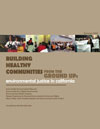 Building Healthy Communities from the Ground Up: Environmental Justice in California (pdf) Building Healthy Communities from the Ground Up: Environmental Justice in California (pdf) 
REPORT by the Asian Pacic Environmental Network et al., September 2003 A report on the landscape of statewide conditions as well as opportunities and challenges for building grassroots power and influence at the state level, using the framework of social justice. The report is designed to inform legislators and policymakers of the history of neglect and inadequate enforcement of environmental protections in California, and to identify policy, legislative, program, and investment gaps, and as a reference document to support direct organizing efforts and coalition-building. The reports contains recommendations and strategies for improving environmental justice in the state. |
 |
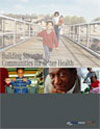 Building Stronger Communities for Better Health Building Stronger Communities for Better Health 
REPORT from Health Policy Institute & Policy Link This brief offers a framework for strengthening communities to improve the health and well-being of residents. One of four publications that outline strategies for achieving better health through community-focused solutions, this report is based on a review of the literature as well as on interviews with African American and Latino community health leaders (or those serving African American and Latino populations) and elected officials from across the country. |
 |
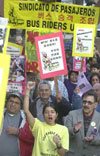 Bus Riders Union Bus Riders Union 
WEB SITE The Bus Riders Union, a project of the Labor/Community Strategy Center, is a progressive civil rights and environmental justice membership organization. Its work begins with the mass transit and public health needs of the Black community, the multiple communities of the African Diaspora, Latinoamericanos, Asian/Pacific Islanders, Indigenous communities,and working class whites who are transit dependent in Los Angeles. The Bus Riders Union seeks to promote environmentally sustainable public transportation for the entire population of Los Angeles, on the premise that affordable, efficient, and environmentally sound mass transit is a human right. |
 |
 Center on the Developing Child Center on the Developing Child 
WEBSITE The Center on the Developing Child was founded in 2006 on the belief that the vitality and sustainability of any society depend on the extent to which it equalizes opportunities early in life for all children to achieve their full potential and engage in responsible and productive citizenship. They view healthy child development as the foundation of economic prosperity and strong communities, and our mission is to advance that vision by leveraging science to enhance child well-being.
The site includes a list of the Center's excellent publications.
|
 |
 Charts and State by State Data Charts and State by State Data 
RWJF Commission to Build a Healthier America The Commission provides an in-depth collection of graphical data ready to download into relevant research and presentations on a range of issues from maternal education and infant mortality to income and life expectancy to placing the U.S. in a global context. Charts can be filtered by social factors or by health conditions.
Their State-by-State Data page allows for sorting charts by state and includes an Education and Health Calculator to compare your state to others.
|
 |
 Child Friendly Cities Child Friendly Cities 
WEB SITE, Project supported by UNICEF A Child Friendly City is actively engaged in fulfilling the right of every young citizen to: Influence decisions about their city: Express their opinion on the city they want; Participate in family, community and social life; Receive basic services such as health care and education; Drink safe water and have access to proper sanitation; Be protected from exploitation, violence and abuse; Walk safely in the streets on their own; Meet friends and play; Have green spaces for plants and animals; Live in an unpolluted environment; Participate in cultural and social events; Be an equal citizen of their city with access to every service,regardless of ethnic origin, religion, income, gender or disability.
|
 |
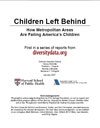 Children Left Behind: How Metropolitan Areas Are Failing America's Children (pdf) Children Left Behind: How Metropolitan Areas Are Failing America's Children (pdf) 
REPORT from DiversityData.org, January 2007
This report finds that across metropolitan America, black and Hispanic children face particularly severe challenges. Inequalities go far beyond what can be explained by income differences, as poor black and Hispanic children tend to encounter environments considerably worse than poor white and Asian children. Yet the very conditions that contribute to these inequalities suggest some possible policy solutions.
The analysis contained in this report is derived from diversitydata.org, a website using data from multiple sources to profile U.S. metropolitan areas's indicators on many dimensions of well-being, including housing, neighborhood conditions, residential integration, education and health. |
 |
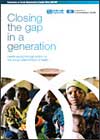 Closing the Gap in a Generation Closing the Gap in a Generation 
FINAL REPORT from Commission on the Social Determinants of Health A project of the World Health Organization (WHO), the Commission on Social Determinants of Health (CSDH) supports countries and global health partners to address the social factors leading to ill health and inequities. It draws the attention of society to the social determinants of health that are known to be among the worst causes of poor health and inequalities between and within countries. The determinants include unemployment, unsafe workplaces, urban slums, globalization and lack of access to health systems. The Web site also contains final reports from the different knowledge networks, as well as additional background articles and resources. |
 |
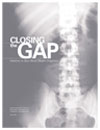 Closing the Gap: Solutions to Race-Based Health Disparities Closing the Gap: Solutions to Race-Based Health Disparities 
REPORT from the Applied Research Center and Northwest Federation of Community Organizations, 2005 Unhealthy neighborhoods and lack of health care contribute to poor health, and they are unequally distributed. People of color are exposed to greater threats and have less access to quality care. This report outlines causes of inequities as well as promising initiatves around the country to combat them. One chapter focuses on Tohono O'odham Community Action (www.tocaonline.org) an organization co-founded by Terrol Dew Johnson, who appears in the episode "Bad Sugar."
|
 |
 Communities Taking Action: Profiles of Health Equity Communities Taking Action: Profiles of Health Equity 
The Prevention Institute Communities Taking Action is a collection of profiles developed by Prevention Institute that showcase successful community initiatives aimed at improving health equity. These profiles are meant to demonstrate key steps to creating healthy, equitable environments and inspire similar action in other communities and locales. Click on any of the map icons to view and browse the profiles. |
 |
 Data Set Directory of Social Determinants of Health at the Local Level (pdf) Data Set Directory of Social Determinants of Health at the Local Level (pdf) 
DATA SETS REFERENCE, Social Determinants of Health Work Group at the Centers for Disease Control and Prevention
The directory contains an extensive list of existing data sets that can be used to address the need for improved conceptualization and availability of data on how the social environment impacts the health of populations. The data sets are organized according to 12 dimensions, or broad categories, of the social environment. Each dimension is subdivided into various components.
This directory grew out of a project based at the University of Michigan School of Public Health and funded by the Centers for Disease Control and Prevention (CDC). |
 |
 David Williams Interview (pdf) David Williams Interview (pdf) 
EDITED INTERVIEW TRANSCRIPT, Web-exclusive content from UNNATURAL CAUSES In this original interview, David Williams, Harvard professor and executive director of the Robert Wood Johnson Foundation Commission to Build a Healthier America, discusses how race and class relate, how poor circumstances cluster geographically, and why political power is good for your health. |
 |
 Designing and Building Healthy Places Designing and Building Healthy Places 
WEB SITE by the Centers for Disease Control As the leading public health agency in the United States, the Centers for Disease Control and Prevention (CDC) scientifically considers all factors that affect the health of the nation. As we embark into the 21st century, the interaction between people and their environments, natural as well as human-made, continues to emerge as a major issue concerning public health.
CDC recognizes several significant health issues that are related to land use, including: Accessibility; Children's Health & the Built Environment; Elders' Health & the Built Environment; Gentrification; Health Impact Assessment; Injury, Mental Health; Physical Activity; Respiratory Health & Air Pollution; Social Capital; Water Quality. |
 |
 DiversityData DiversityData 
DATABASE of the Harvard School of Public Health and The Center for the Advancement of Health DiversityData is an interactive website on socioeconomic indicators in U.S. metropolitan areas. |
 |
 Dwelling Disparities: How Poor Housing Leads to Poor Health Dwelling Disparities: How Poor Housing Leads to Poor Health 
SCHOLARLY ARTICLE by Ernie Hood, Environmental Health Perspectives, May 2005 Recently, the scope of environmental health science has broadened to encompass how the built environment affects human health. Many groups are focusing research efforts on how inadequate housing in particular contributes to poor health. Low-income and minority populations are known to be especially at risk for housing-related adverse health effects. Yet fully elucidating the links between the built environment and health disparities is a huge task, one that is requiring new tools and research methods. Community groups are increasingly being brought into the research loop to ensure that efforts to identify and reduce health problems are appropriately targeted. |
 |
| 1 | 2 | 3 | 4 | 5 Next » |
|




